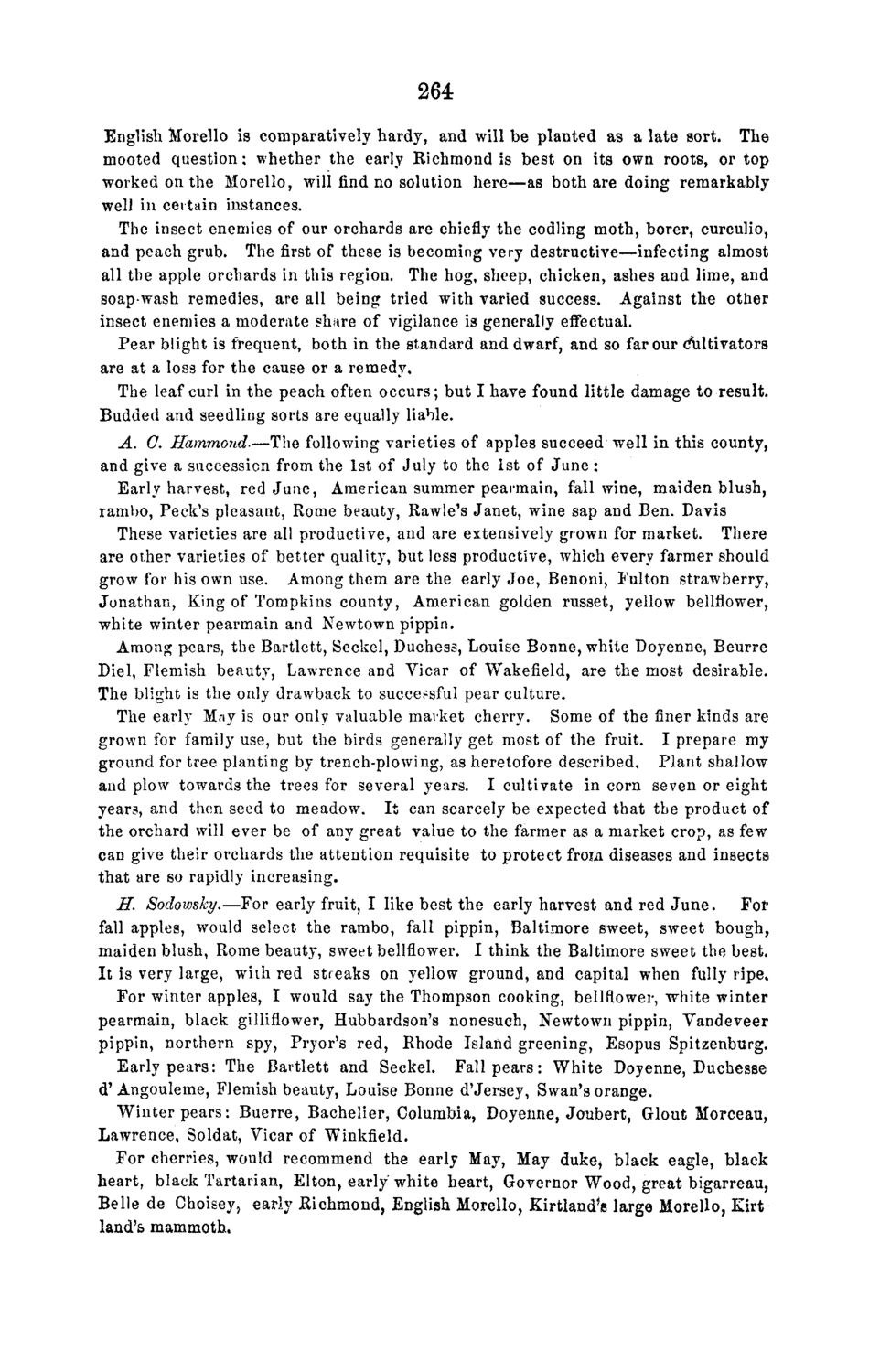| |
| |
Caption: Board of Trustees Minutes - 1868
This is a reduced-resolution page image for fast online browsing.

EXTRACTED TEXT FROM PAGE:
264 English Morello is comparatively hardy, and will be planted as a late sort. The mooted question: whether the early Richmond is best on its own roots, or top worked on the Morello, will find no solution here—as both are doing remarkably well in certain instances. The insect enemies of our orchards are chiefly the codling moth, borer, curculio, and peach grub. The first of these is becoming very destructive—infecting almost all the apple orchards in this region. The hog, sheep, chicken, ashes and lime, and soap-wash remedies, are all being tried with varied success. Against the other insect enemies a moderate share of vigilance is generally effectual. Pear blight is frequent, both in the standard and dwarf, and so far our cultivators are at a loss for the cause or a remedy. The leaf curl in the peach often occurs; but I have found little damage to result. Budded and seedling sorts are equally liable. A. 0. Hammond.—The following varieties of apples succeed well in this county, and give a succession from the 1st of July to the 1st of June : Early harvest, red June, American summer pearmain, fall wine, maiden blush, rambo, Peck's pleasant, Rome beauty, Rawle's Janet, wine sap and Ben. Davis These varieties are all productive, and are extensively grown for market. There are other varieties of better quality, but less productive, which every farmer should grow for his own use. Among them are the early Joe, Benoni, Fulton strawberry, Jonathan, King of Tompkins county, American golden russet, yellow bellflower, white winter pearmain and Newtown pippin. Among pears, the Bartlett, Seckel, Duchess, Louise Bonne, white Doyenne, Beurre Diel, Flemish beauty, Lawrence and Yicar of Wakefield, are the most desirable. The blight is the only drawback to successful pear culture. The early May is our only valuable market cherry. Some of the finer kinds are grown for family use, but the birds generally get most of the fruit. I prepare my ground for tree planting by trench-plowing, as heretofore described. Plant shallow and plow towards the trees for several years. I cultivate in corn seven or eight years, and then seed to meadow. It can scarcely be expected that the product of the orchard will ever be of any great value to the farmer as a market crop, as few can give their orchards the attention requisite to protect from diseases and insects that are so rapidly increasing. H. Sodowsky.—For early fruit, I like best the early harvest and red June. For fall apples, would select the rambo, fall pippin, Baltimore sweet, sweet bough, maiden blush, Rome beauty, sweet bellflower. I think the Baltimore sweet the best. It is very large, with red streaks on yellow ground, and capital when fully ripe. For winter apples, I would say the Thompson cooking, bellflower, white winter pearmain, black gilliflower, Hubbardson's nonesuch, Newtown pippin, Yandeveer pippin, northern spy, Pryor's red, Rhode Island greening, Esopus Spitzenburg. Early pears: The Bartlett and Seckel. Fall pears: White Doyenne, Duchesse d' Angouleme, Flemish beauty, Louise Bonne d'Jersey, Swan's orange. Winter pears: Buerre, Bachelier, Columbia, Doyenne, Joubert, Glout Morceau, Lawrence, Soldat, Vicar of Winkfield. For cherries, would recommend the early May, May duke* black eagle, black heart, black Tartarian, Elton, early white heart, Governor Wood, great bigarreau, Belle de Choisey, early Richmond, English Morello, Kirtland's large Morello, Kirt land's mammoth,
| |